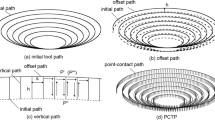Abstract
Incremental sheet forming (ISF) is considered as a flexible sheet metal forming process suitable for rapidly producing complex sheet metal parts, and the tool path has a vital impact on the forming quality. The balance between efficiency and geometric accuracy is still challenging in tool path generation algorithm for the ISF process. In the present work, a novel quadratic spiral tool path (QSTP) generation algorithm has been developed for the ISF process. For better understanding the impact of QSTP, the thickness thinning, forming cycle time, geometric accuracy, and surface quality are case-studied by using two typical parts with varied wall angle and compared with conventional spiral tool path (CSTP). Two different materials AA5052 and DC05 are used to evaluate the influences of sheet material properties. In addition, an analytical model is proposed to evaluate the surface quality of the part made by QSTP, which is also validated by experiments. Experimental results confirm that QSTP can improve surface quality and geometric accuracy, reduce horizontal forming force, and relieve severe thickness thinning compared with CSTP. Results also demonstrate that QSTP generates smoother and shorter tool path compared with CSTP, which ensures the reduction of forming cycle time. Experimental comparison in forming AA5052 and DC05 by QSTP shows that larger ratio of yield stress to Young’s module of the sheet metal may cause larger geometric deviation, but the material properties do not affect the thickness thinning mode which still generally follows the Cosine law in QSTP.
Similar content being viewed by others
References
Jeswiet J, Micari F, Hirt G, Bramley A, Duflou J, Allwood J (2005) Asymmetric incremental sheet forming. Adv Mater Res 6–8:35–58
Wang J, Li LH, Zhou P, Wang X, Sun SF (2018) Improving formability of sheet metals in incremental forming by equal diameter spiral tool path. Int J Adv Manuf Technol 89:3527–3534
Wen T, Chen X, Zheng J, Qing J, Tang ZX (2017) Multi-directional incremental sheet forming-a novel methodology for flexibly producing thin-walled parts. Int J Adv Manuf Technol 91:1909–1919
Filice L, Fratini L, Micari F (2002) Analysis of material formability in incremental forming. CIRP Ann Manuf Technol 51(1):199–202
Zhu H, Liu ZJ, Fu JH (2011) Spiral tool-path generation with constant scallop height for sheet metal CNC incremental forming. Int J Adv Manuf Technol 54:911–919
Lu B, Ou H, Chen J, Cao J, (2011) An adaptive tool path generation and optimisation method for single point incremental sheet forming, Proceedings of the 10th International Conference on Technology of Plasticity, ICTP, 507-512.
Lu B, Ou H, Chen J, Cao J, (2011) An adaptive tool path generation and optimisation method for single point incremental sheet forming, Proceedings of the 10th International Conference on Technology of Plasticity, ICTP2011, 507–512
Attanasio A, Ceretti E, Giardini C, Mazzoni L (2008) Asymmetric two points incremental forming: improving surface quality and geometric accuracy by tool path optimization. J Mater Process Technol 197(1-3):59–67
Hagan E, Jeswiet J (2004) Analysis of surface roughness for parts formed by computer numerical controlled incremental forming. Proc Inst Mech Eng B 218:1307–1312
Hussain G, Gao L (2007) A novel method to test the thinning limits of sheet metals in negative incremental forming. Int J Mach Tools Manuf 47(3):419–435
Lu B, Fang Y, Xu DK, Chen J, Ou H, Moser NH, Cao J (2014) Mechanism investigation of friction-related effects in single point incremental forming using a developed oblique roller-ball tool. Int J Mach Tools Manuf 85:14–29
Funding
This study was financially supported by the National Natural Science Foundation of China through grant no. U1737210.
Author information
Authors and Affiliations
Corresponding author
Additional information
Publisher’s note
Springer Nature remains neutral with regard to jurisdictional claims in published maps and institutional affiliations.
Rights and permissions
About this article
Cite this article
Chang, Z., Li, M., Li, M. et al. Investigations on a novel quadratic spiral tool path and its effect on incremental sheet forming process . Int J Adv Manuf Technol 103, 2953–2964 (2019). https://doi.org/10.1007/s00170-019-03649-7
Received:
Accepted:
Published:
Issue Date:
DOI: https://doi.org/10.1007/s00170-019-03649-7




